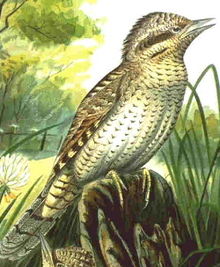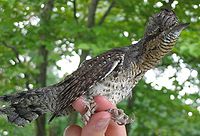Wryneck
| Wrynecks | |
|---|---|

| |
| Eurasian wryneck (Jynx torquilla) | |
| Scientific classification | |
| Domain: | Eukaryota |
| Kingdom: | Animalia |
| Phylum: | Chordata |
| Class: | Aves |
| Order: | Piciformes |
| Family: | Picidae |
| Subfamily: | Jynginae |
| Genus: | Jynx Linnaeus, 1758 |
| Species | |
|
J. torquilla | |
The wrynecks (genus Jynx) are a small but distinctive group of small Old World woodpeckers. Jynx is from the Ancient Greek iunx, the Eurasian wryneck.[1]
Like the true woodpeckers, wrynecks have large heads, long tongues which they use to extract their insect prey and zygodactyl feet, with two toes pointing forward, and two backwards. However, they lack the stiff tail feathers that the true woodpeckers use when climbing trees, so they are more likely than their relatives to perch on a branch rather than an upright trunk.
Their bills are shorter and less dagger-like than in the true woodpeckers, but their chief prey are ants and other insects, which they find in decaying wood or almost bare soil. They re-use woodpecker holes for nesting, rather than making their own holes. The eggs are white, as with many hole nesters.
The two species have cryptic plumage, with intricate patterning of greys and browns. The adult moults rapidly between July and September, although some moult continues in its winter quarters.[2] The voice is a nasal woodpecker-like call.
These birds get their English name from their ability to turn their heads almost 180 degrees. When disturbed at the nest, they use this snake-like head twisting and hissing as a threat display.
There are two species:
| Image | Scientific name | Common Name | Distribution |
|---|---|---|---|
 |
Jynx torquilla | Eurasian wryneck | north it reaches the Arctic Circle and the range includes Spain in the southwest |
 |
Jynx ruficollis | Red-throated wryneck, or Rufous-necked wryneck, | sub-Saharan Africa |
-
Wryneck, Village, Behlolpur, district Mohali, Punjab, India
-
Eurasian wryneck
References
- ^ Jobling, James A (2010). The Helm Dictionary of Scientific Bird Names. London: Christopher Helm. p. 212. ISBN 978-1-4081-2501-4.
- ^ RSPB Handbook of British Birds (2014). UK. ISBN 978-1-4729-0647-2.


